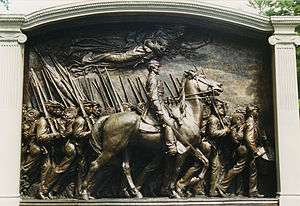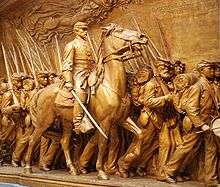Robert Gould Shaw Memorial
| Robert Gould Shaw Memorial | |
|---|---|
 | |
| Artist | Augustus Saint-Gaudens |
| Year | 1884 |
| Type | Bronze |
| Dimensions | 3.4 m × 4.3 m (11 ft × 14 ft) |
| Location | Boston, Massachusetts, U.S. |
| 42°21′27″N 71°3′48.6″W / 42.35750°N 71.063500°W | |
| Owner | National Park Service |
The Memorial to Robert Gould Shaw and the Massachusetts Fifty-Fourth Regiment is a bronze relief sculpture by Augustus Saint-Gaudens at 24 Beacon Street, Boston (at the edge of the Boston Common), depicting Col. Shaw and the 54th Regiment Massachusetts Volunteer Infantry, marching down Beacon Street on May 28, 1863. It was unveiled May 31, 1897.[1]
History
In the autumn of 1865 a meeting was held in the council chamber at the State House, at the call of Governor Andrew, Dr. Samuel G. Howe, Senator Charles Sumner, Colonel Henry Lee, Mr. J. B. Smith, and others, to consider the matter of a suitable memorial to Robert G. Shaw, the late commander of the Massachusetts Fifty-fourth Regiment. The prime mover in this matter was doubtless the late Joshua B. Smith, a fugitive from slavery, who after his escape had been in the service of Colonel Shaw's family before he took the position of repute as the successful caterer, in which he became so well known in Boston. The purpose of the meeting was declared in the following words:
"The monument is intended not only to mark the public gratitude to the fallen hero, who at a critical moment assumed a perilous responsibility, but also to commemorate that great event, wherein he was a leader, by which the title of colored men as citizen-soldiers was fixed beyond recall. In such a work all who honor youthful dedication to a noble cause and who rejoice in the triumph of freedom should have an opportunity to contribute." [2]
An inscription on the relief itself reads OMNIA RELINQVIT / SERVARE REMPVBLICAM ("He left behind everything to save the Republic"). The pedestal below carries lines from James Russell Lowell's poem "Memoriae Positum":
Right in the van of the red rampart's slippery
swell with heart that beat a charge he fell
foeward as fits a man: but the high soul burns
on to light men's feet where death for noble
ends makes dying sweet.
On the rear are the words of Charles W. Eliot:
The White Officers taking life and honor in their hands cast in their lot with men of a despised race unproven in war and risked death as inciters of servile insurrection if taken prisoners besides encountering all the common perils of camp march and battle. The Black rank and file volunteered when disaster clouded the Union Cause. Served without pay for eighteen months till given that of white troops. Faced threatened enslavement if captured. Were brave in action. Patient under heavy and dangerous labors. And cheerful amid hardships and privations. Together they gave to the Nation and the World undying proof that Americans of African descent possess the pride, courage and devotion of the patriot soldier. One hundred and eighty thousand such Americans enlisted under the Union Flag in MDCCCLXIII-MDCCCLXV.[3]

A plaster cast, which exhibited at the 1901 Pan-American Exposition, is at the National Gallery of Art,[4] on loan by the Saint-Gaudens National Historic Site, Cornish, New Hampshire.[5] The inscription running along the bottom of the plaster cast incorrectly states that the assault on Fort Wagner and Shaw's death in 1863 occurred "JULY TWENTY THIRD," five days later than the actual events.
In popular culture
The "St. Gaudens" in Boston Common (Col. Shaw and his Colored Regiment), is the first movement of Three Places in New England (1903-1929), by Charles Ives.
The Robert Gould Shaw Memorial by Augustus Saint-Gaudens is referenced in Robert Lowell's famous poem For the Union Dead (1964) with a drawing of the relief appearing on the cover of the first edition of the book by the same name.
The memorial was depicted in the ending credits scene of the 1989 film Glory.
It was used as the background for the U.S. postage stamp honoring author and poet Stephen Vincent Benet on the 100th anniversary of his birth in 1998.
See also
References
- ↑ http://www.nps.gov/boaf/historyculture/shaw.htm
- ↑ The Monument to Robert Gould Shaw: Its Inception,completion, and Unveiling . 1997. Retrieved June 30, 2013.
- ↑ "Memorial to Robert Gould Shaw, (sculpture)". Save Outdoor Sculpture, Massachusetts survey. 1997. Retrieved October 22, 2011.
- ↑ http://www.nga.gov/feature/shaw/
- ↑ "Memorial to Robert Gould Shaw, (sculpture)". Save Outdoor Sculpture, New Hampshire survey. 1993. Retrieved October 22, 2011.
External links
| Wikimedia Commons has media related to Robert Gould Shaw Memorial. |
- http://www.celebrateboston.com/sites/shaw-memorial.htm
- http://www.sgnhs.org/Augustus%20SGaudens%20CD-HTML/Monuments/CivilWar/Shaw1.htm
- http://ctmonuments.net/2010/05/robert-gould-shaw-memorial-boston/
- http://iwalkedaudiotours.com/2011/04/iwalked-bostons-common-shaw-memorial/
- http://www.artbabble.org/video/ngadc/shaw-memorial-1900-augustus-saint-gaudens
- Augustus Saint-Gaudens, Master Sculptor, exhibition catalog fully online as PDF from The Metropolitan Museum of Art, which contains material on the Robert Gould Shaw Memorial